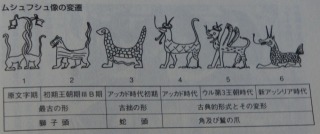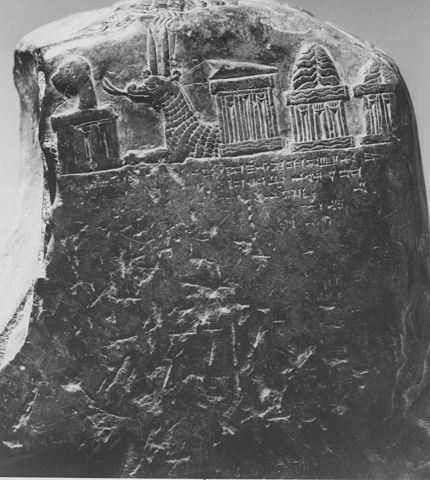
唐草とともに
バビロニアの境界石
聖樹聖獣文様

Babylonian boundary-stones
kudurru


Babylonian boundary-stones and memorial tablets in the British Museum, No. LXXXIII バビロニアの境界石 大英博物館蔵the British Museum, room 55.
 ジョゼフ・キャンベルの『神話のイメージ』、ウルクの大鉢(ワルカの壺)のあとには、このバビロニアの境界石が出ている。(p86 図74.75)。展開図は例のごとく、マーク・ハッセルリースによる。
ジョゼフ・キャンベルの『神話のイメージ』、ウルクの大鉢(ワルカの壺)のあとには、このバビロニアの境界石が出ている。(p86 図74.75)。展開図は例のごとく、マーク・ハッセルリースによる。

Wikipediaを見たところ、ネブカドネザル1世(英語版)の項に、6段あるうち下から2段目の部分のみ出ていた。
全部あるとうれしいのだが・・と思いつつしばらく見ていたのだが、どうも話が違っているようだ。
キャンベルの記述では、地女神グラとしているが、Wikipediaの図をみると髯のように黒いものががあり男性のように見える。
しかしメソポタミアの図像でこんな形の髯は見たことがないし、大英博物館のサイトにあるイメージを見ると目鼻だちなどはよくわからない。フリッカーをみても同様である。
マーク・ハッセルリースの展開図では、男性のように見えるし、マルドゥック・アッへ王(前1099~1082)(※)の時代のものは、国王自身が弓を持つ射手である。
しかし、こちらのネブカドネザル1世の境界石のこの人物は、神の椅子に坐る・・・やはり女神だろうか。従えているムシュフシュ(※)も、この段ではどうやら・・・まったくの犬のようにもみえるが・・。
グラ=イシン市の女神で、医術・治癒を司る神として崇められた。
(p87) 世界山の6つの段階の上に顕現した神の姿。
上段は神の領域・・左から右へ、
女神イシュタルの金星、月神シンの三日月、太陽神シャマシュの太陽に象徴される
各段を順に降りて深淵をなす水の領域までの一連の下降の場面が描かれている。
彫刻を施された石の左側の蛇は石の前面からは見えないが、上方で体を曲げて三日月の盃の上に頭を表している。
蛇のなめらかに身をうねらせるさまは水を暗示し、裂けた赤い舌は焔(火)を暗示する
 この辺りのキャンベルの書きぶりは非常に文学的で趣はあるのだが。
この辺りのキャンベルの書きぶりは非常に文学的で趣はあるのだが。
2段目は神々のターバンを戴いた三つの礼拝堂(一説には玉座) 天空の神アヌ、大気と大地の神エンリル、そして、「大海の家」に住むエア(エンキ、エアネス)
3段目はバビロンを特別に守護する神々の座と象徴
都市の守護神マルドゥック(エアの息子)、彼を象徴する動物はドラゴン
先触れ役の書記法と知恵の神名部―(マルドゥックの息子)、象徴動物はヤギ
女神で王妃の山の母神ニンフルサグ-ニンリル
4段目地上の平面の様子 人間を取り囲む環境 世界の四方位の 守護者を表す基柱。右手の奇妙なタカの頭の柱、双頭のライオンの柱(キシュのザママと、ニップールのニニムのエンブレム)、ウマの頭の像は外来の戦いの神のエンブレム、その右手のみすぼらしいワシも名前の確認されていない戦いの神のエンブレム
5段目(地面の下)地女神グラが座りその背後から宇宙蛇が立ちあがる
花柄の衣装が示すように、グラは薬草、治癒、萌えいずる生命の守護神である。
彼女は家の守護神である犬を傍らにおき、両手を差し出して祈るような姿勢で座っている。
一方女神の前には「サソリの姿をした射手」が宇宙の海の岸辺で警護にあたり、昇る太陽と沈む太陽を守っている。
6段目 一番底にある深淵をなす海には、上方に存在する、万物を作る四大要素の象徴が見られる。
右手に火の神ヌスクのランプ、
左手に嵐の神ラマン-アダドの雄ウシと稲妻、
地上に住んで死を分配するサソリ、サソリの上を泳ぐカメ。カメはその小さな足で宇宙山全体を支えている。
ヌスク・・アヌ(光、火)、ラマン-アダド・・エンリル(大気)、カメ・・エア(水)、サソリ・・グラ女神のサソリの姿の射手と対応
宇宙全体が四大要素を対応したもの
The texts list thirteen high officials who were present at the granting of the charter, and invokes nine gods to protect the monument. There are also twenty divine symbols carved in relief.
D. Collon, Ancient Near Eastern art (London, The British Museum Press, 1995)https://www.britishmuseum.org/・・
Boundary stone (kudurru)
Kassite dynasty, about 1125-1100 BC
Probably from southern Iraq
◆British Museum - Boundary stone (kudurru)
◆https://www.mazzaroth.com/ScorpioAndBoundaryStones
◆https://www.liceozanella.it/multimed/lavoritriennio/imago/meso/kudurru/
ネブカドネザル1世(前12世紀)
Wikipediaネブカドネザル1世(Nebuchadnezzar I、在位:紀元前1125年頃 - 紀元前1104年頃)は古代メソポタミア、イシン第2王朝(バビロン第4王朝)の王である。同王朝の王の中で最もよく知られている。なお、ネブカドネザルという名前は旧約聖書のヘブライ語表記に基づいており、アッカド語(バビロニア語)ではナブー・クドゥリ・ウツル(Nabu Kudurri Usur)と表記される。
a kudurru (stele) of King Melishipak I (1186–1172 BC) Babylonian boundary-stones and memorial tablets in the British Museum
 キャンベルの本のものが大英博物館蔵とあったので大英博物館の方を見てみたのだが、『大英博物館のA からZまで』では別のものしか見られない。大英博物館には24点収蔵されているというが、ルーブルにも4~5(?)あるようだ。
キャンベルの本のものが大英博物館蔵とあったので大英博物館の方を見てみたのだが、『大英博物館のA からZまで』では別のものしか見られない。大英博物館には24点収蔵されているというが、ルーブルにも4~5(?)あるようだ。
(※https://flickrhivemind.net/Tags/kudurru)
ルーブル美術館の方の、別のクドゥルの説明、聖書に関連付けてものだが)神のイメージとシンボルについて、図に名入りでわかりやすい
。
https://english.louvrebible.org/・・

Kudurru (stele) of King Melishipak I (1186–1172 BC):
the king presents his daughter to the goddess Nannaya.
The crescent moon represents the god Sin, the sun the Shamash and the star the goddess Ishtar.
Kassite period, taken to Susa in the 12th century BC as war booty.
 ネブカドネザル1世のもの、キャンベルの記述では、地女神グラとしているが、男性像のようにも見えたかもしれない件であるが、ルーブルのLarge Kudurru of King MelishipakⅠのもの、王は玉座の神に娘を紹介しているという記述で、その神は女神ナナンナとする。そちらはひげはなく髪を結っている。確かに女神。
ネブカドネザル1世のもの、キャンベルの記述では、地女神グラとしているが、男性像のようにも見えたかもしれない件であるが、ルーブルのLarge Kudurru of King MelishipakⅠのもの、王は玉座の神に娘を紹介しているという記述で、その神は女神ナナンナとする。そちらはひげはなく髪を結っている。確かに女神。

Kudurru of King Melishipak II ルーブル蔵
The divine order of the world This kudurru is remarkable in that in recording the royal gift, it represents the entire pantheon of gods who preserve the order of the world. The artist has used a formula that was later to be developed on other kudurrus, representing the symbols associated with each deity in hierarchical rows. At the top of the stele are the astral deities, as if in the vault of the heavens. The crescent of Sin, the moon god, and the star set with the rays of Shamash, the sun god, flank the goddess Ishtar, represented by the planet Venus. They are accompanied by the sovereign gods who preserve the equilibrium of the world. The crowns with six rows of horns placed on the altars are the emblems of Anu, the sky god, and Enlil, the air god. They are followed by the ram's head and the goatfish representing Ea, the god of fresh water, and the symbol of Ninhursag, the earth goddess. On the row immediately underneath are the warrior gods, whose victories in battle protect the order of the world - Nergal, represented by a weapon mounted on a dragon's back; Zababa, shown by a weapon with the head of a bird of prey; and Ninurta, depicted by a weapon with the head of a lion. Just beneath them is the figure of Marduk, the demiurge and protector of Babylonia, represented by a pointed spade and a horned dragon. He is accompanied by Nabu, the god of scribes, represented by a tablet and calamus, and Gula, goddess of medicine, astride her dog. The gods of earthly fertility are shown on the lowest level - the bolt of lightning and the bull of Adad, the god of storms; the lamp of Nushku, god of fire; the plow of Ningirsu, originally the god of farming; and the birds of Shuqamuna and Shumalia, the divine couple of the Kassite pantheon. On the ground, ready to strike, are the snake and the scorpion, representing the Chtonian deities of the underworld. The spatial ordering in rows represents the hierarchy of the deities and presents the Babylonian pantheon as a symbolic microcosm. The layout reflects both the divine ordering of the cosmos and the hierarchy of the pantheon.
このクルドゥルには世界の秩序を支配する主要な神々をひとまとめにして、王の贈与保障人として集合させるという特殊性がある。
定型化しつつある一般原則に従い、これらの神々はシンボルによって幾段にも重ね区分するやり方で碑の上に描かれる。
碑の頂部には、天上界にかかげられたように天体を司る神々がいて、
三日月の月神シンと光り輝く星の太陽神シュマシュが金星を表す星形のイシュタル女神を囲んでいる。
これらには、世界の均衡を支配する最高の神々が同行されている。
祭壇に置かれた7列の角冠は天空神アヌと大気神エンリルのシンボルである。そこへ水神エアの随獣であるヤギの頭とヤギ・魚の混成動物、それから大地の女神ニンフルザクのシンボルが続いている。
次の段には、戦勝により世界秩序の保護を保障する戦士の神々が登場し、龍の上に載る武器によって象徴されるネルガル、猛禽の頭をもつ武器よってザババ、そして獅子の頭をもつ武器によってニヌルタが象徴されている。
その下の3段目では、尖った鋤と角のある龍で表されたバビロン市の造物神であり守護神であるマルドゥクがくる。彼は粘土板と葦の筆で描かれた書記神ナブーと犬の随獣の上に描かれた治癒女神グラを連添っている。
地表にあたる4段目では、土地の豊饒を司る神々が窺え、実際そこに雷雨神アダドが稲妻と牡牛、火の神ヌシュクがランプ、本来農業の神ニンギルスが犂(すき)、およびカッシートの夫婦神シュカムラとシマリア女神の二羽の鳥が続いている。
最下段には、地表下を這いながら常に突如と現れる用意周到した、地獄の冥界の神々のシンボルである蛇と蠍(さそり)が潜んでいる。
このクドゥルは、偉大な神々のシンボルを段に振り分け重ねるという構成もちながら、本物と同じような象徴化された小宇宙の外観を呈している。その空間配分では、すべての神々の階級に基づいて打ち立てられる宇宙の機能組織の反映としてそこへ登場させている。
出典 - MORGAN Jacques (de), Mémoires I, Leroux, 1900, p. 172, pl. XVI-3
This is an example of a kudurru (kudurrus are small stelae recording royal gifts of land). This particular kudurru records a grant of land from King Melishipak II to his son, Marduk-apal-iddina. Kudurrus were an innovation of the Kassite period, and King Melishipak was a Kassite. One side of the kudurru shows the King presenting his son to the goddess Nanaya beneath the symbols of the astral deities, Shamash (sun-god), Sin (moon-god), and Inana (goddess of love and war, but also representing Venus). On the other side of the kudurru the major gods are depicted in symbol form in hierarchical registers. It is interesting to note that the Kassite deities, Shuqamuna and Shumalia, are included among the major deities.
 こちら、ルーブル美術館の記述では娘でなく息子となっている
。KuThis example recordsa gift of land made by King Melishipak to his son Marduk-Apal-Iddina.)
こちら、ルーブル美術館の記述では娘でなく息子となっている
。KuThis example recordsa gift of land made by King Melishipak to his son Marduk-Apal-Iddina.)
Wikipediaと
https://traveltoeat.com/babylonian-kudurru-at-the-louvre-2/こちらは娘で、別のもの?(裏表かと思っています(~_~;)

マルドゥック・アッへ王(前1099~1082)の時代 大英博物館蔵 高さ61センチ
王像の右に「境界を定めたものは永遠なり」とあり、王は弓と矢を携え、刺し子の沓をはき、ロゼッタ文と有翼牡牛文、樹木文のある羽根飾りのついたバビロニアの冠を被っている。王の上には神々のシンボルと蛇が描かれた図像部と側面にある碑文との区切りとなっている。(『大英博物館のA からZまで』byマージョリー・ケイギル)
カッシートの遺物で最もよく知られているのは、いわゆる境界石(クドゥツル)であろう。これは不整形の石で、銘文と神の像や国王の像が刻まれており、土地の所有権や特権を永久に記録するために作られた。前14世紀に製作されるようになり、前12世紀にもっとも盛んになった。(マージョリー・ケイギル)
彼らは前1500年ごろ、東北の山地からバビロニアの地に入って着たらしい。ほぼ200年にわたってカッシート王国は西アジアの大国として君臨し、ヒッタイトやエジプトと大使の交換も行っていたが、前1157年ごろに西南イランのエラム王国によって滅ぼされたという(大英博物館 マージョリー・ケイギル)

Boundary stone (kudurru) Marduk-nadin-ahhe
https://en.wikipedia.org/wiki/Marduk-nadin-ahhe
2nd Dynasty of Isin, about 1099-1082 BC From Babylon,
southern Iraq 'The Establisher of the Boundary forever
' ※https://www.britishmuseum.org/explore/・・ 別アングルでわきの蛇が見える
※flickr でも写真が見られる
en.wikipedaKudurrus_of_Isin_(Babylonian)_king_Marduk-nadin-ahhe_(ca_1099-1082_BC)




クドゥル
A "kudurru," the Akkadian term for boundary stoneことバンクより
カッシート時代後期から,バビロニアではクドゥルkudurruと呼ばれる石彫品が作られるようになる。縦長の石材の表面に神々のシンボル(太陽,月,雷,または動物など),人物像などが浮彫で表され,さらに銘文が刻みつけられた。…
https://kotobank.jp/word/kudurruブリタニカより
kudurru, (Akkadian: “frontier,” or “boundary”), type of boundary stone used by the Kassites of ancient Mesopotamia.
A stone block or slab, it served as a record of a grant of land made by the king to a favoured person.
The original kudurrus were kept in temples, while clay copies were given to the landowners. On the stone were engraved the clauses of the contract, the images or symbols of the gods under whose protection the gift was placed, and the curse on those who violated the rights conferred・・・
![]() 『古代メソポタミアの神々 世界最古の「王と神の饗宴」』p220 ムシュフシュ像の変遷⇒
『古代メソポタミアの神々 世界最古の「王と神の饗宴」』p220 ムシュフシュ像の変遷⇒

バビロンの蛇へ続く)
検索
ルーブルのUnfinished Kudurru(未完のクドゥル)

https://smarthistory.khanacademy.org/unfinished-kudurru.html
冠を被る蛇の象形文字(白川静)

シュメール人の世界感覚を知るうえでカギとなる思想は、[上にあるものは下にある]という考え方である。上にあるものが降り、下にあるものが昇る。人間は地上の衣装をまとった「神の姿」全ての玉座は天界の玉座をかたどったもの。
空間的象徴主義
 どうやらここで、
どうやらここで、





